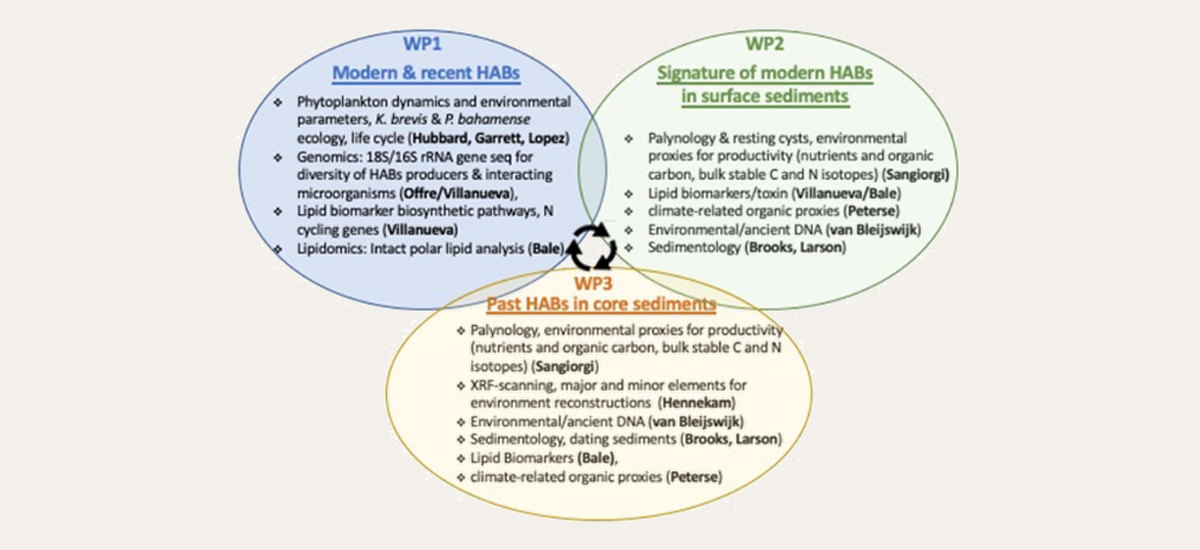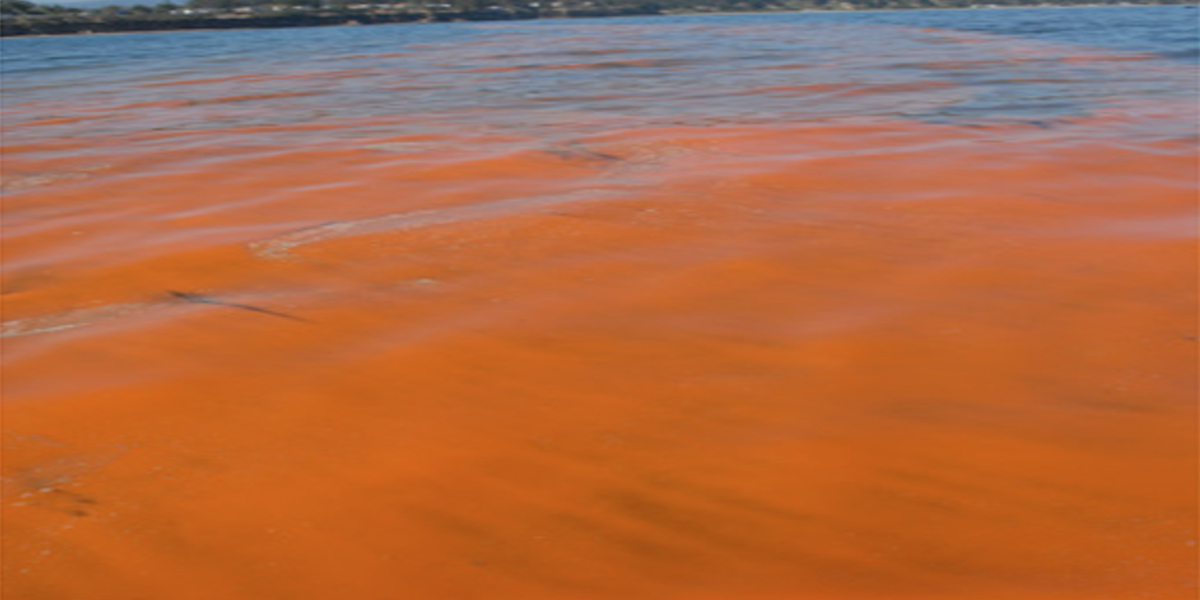Harmful Algal Blooms: have they really become more frequent?
Harmful Algal Blooms (HABs) are phenomena caused by the proliferation of (micro)organisms in a water body. HABs can negatively affect human health (toxins production), the socio-economic sectors (fishery, tourism), ecosystems and the environment. There is growing concern that global climate change and anthropogenic impact are causing an increase in the frequency and intensity of HABs. Florida coastal waters are HAB hotspots, notorious for recurrent blooms of the toxic dinoflagellates (microscopic phytoplanktonic organisms) Karenia brevis and Pyrodinium bahamense. Whether HABs have indeed recently increased depends on knowing their past occurrence, their response to environmental changes on timescales matching and preceding human influence. This project applies a wide array of tools (from genomic to paleoecology) to provide the missing long-term perspective to Florida HABs.
|
|
|
Our collaboration crosses the fields of biology and geology to tackle new challenges in the field of Harmful Algal Blooms. New collaborations and challenges are the fuel that keeps (passion for) science alive. |
| Francesca Sangiorgi, Laura Villanueva |
Project description
Harmful algal blooms (HABs) are natural phenomena caused by the proliferation of organisms (including cyanobacteria, dinoflagellates and diatoms) in a water body. HABs can negatively affect human health (toxins production), the socio-economical sectors (fishery, tourism), ecosystems and the environment. There are concerns that global climate change is increasing the frequency and intensity of HABs. Anthropogenic pressures in coastal areas and rising global temperature result in changes to water physicochemical conditions, which may substantially affect the distribution, frequency and toxicity of HABs1. How different climate drivers will affect HABs remain largely speculative, because changes and responses will vary globally and local factors are expected to determine HAB dynamics. Moreover, understanding if recent anthropogenically-driven climate change and eutrophication have truly increased HABs occurrence depends on establishing a trend from a 'natural' baseline. While valuable, sampling and monitoring efforts have varied widely2, making it difficult to examine trends at time scale relevant to climate dynamics. These data lack a pre-anthropogenic perspective that paleoenvironmental indicators offer. There is hence a need to provide a past perspective to recent and present HABs. Few studies explored this direction by studying fossil parts of organisms3, but this one-discipline approach may fail (e.g., when organisms do not produce fossilizable parts).

Florida’s Gulf coastal and bay-estuarine waters (Tampa Bay, Charlotte Harbor) are notorious and thus excellently monitored HAB hotspots. A combination of (human-mediated) nutrient availability and Gulf of Mexico oceanographical features promote the bloom of, among others, two toxic dinoflagellate species: Karenia brevis and Pyrodinium bahamense. K. brevis produces brevetoxins, neurotoxins that kill marine organisms and threaten public health, and a specific biomarker (brevesterol). Both compounds are detectable in sediments4,5. K. brevis proliferation starts offshore in oligotrophic and is advected into coastal systems where nutrients are abundant and can favor extensive blooms6. K. brevis is capable of using a wide variety of nutrient sources, including nitrogen from N2-fixing cyanobacterium Trichodesmium, other plankton, and dead fish7. Its blooms are well-studied2, but some critical gaps still prevent their prediction, such as the existence and role of a resting cyst stage during its life cycle and the exact environmental, biological and ecological factors causing bloom formation, maintenance and termination. In Florida, P. bahamense blooms are most prevalent in the estuarine waters with long residence time8. It produces saxitoxins, a potent neurotoxin, a (fossilizable) resting cyst9 and a biomarker (methylgorgostanol)10. Recurrent high-biomass P. bahamense blooms are associated with abundant cyst beds, and sesonality has been shown to be an important regulator of cyst dormancy and germination8.
 Aim and approach
Aim and approach
This project wants to provide the first ever systematic reconstruction of Florida HABs in relation to environmental changes, on time scales that match and precede human influence, We use a broad (from genomic to paleoecology) multidisciplinary approach.
- WP1 contributes to the knowledge of modern and recent (past few decades) HAB dynamics (biological interactions, HABs diversity, toxin production and environmental drivers) and integrates new and existing water column monitoring data.
- WP2 focuses on the signature of modern HABs in the surface sediments to calibrate tools employed in the reconstructions.
- WP3 focuses on past HABs, and environmental/climate conditions to identify the baseline of natural HAB occurrence and variability against which modern trends can be compared. We target Holocene at low resolution to account for climate variability11, and focus on the last 1000 years for matching the time scale of human impact. The data will be shared with modelers (in Florida) for future HABs forecasting. All data will be made open access.
Novelty
This project is, to our knowledge, the first ever to use a multidisciplinary integrated approach to detect paleo-HABs. 'Sediment records of [dinoflagellate] cysts distributions provide a potentially rich but strongly under-utilized framework for studying some HAB taxa'1. Next to cyst studies (palynology),we add an array of tools (biomarkers and genomics), to exploit the full potentiality in detecting HAB past occurrence in relation to environmental change. Genomics will provide a complete view of species and interactions in the present and past. Our approach can be applied to any other (HAB) locations.
Research group
Composition of the research group/expertise:
University Utrecht:
Dr. Francesca Sangiorgi (dinoflagellates, palynology, paleoclimate), Dr. Francien Peterse (organic geochemistry, biomarkers);
Royal NIOZ:
Dr. Laura Villanueva (molecular geomicrobiology), Dr. Pierre Offre (microbial physiology), Dr. Judith van Bleijswijk (environmental/ancient DNA), Dr. Nicole Bale (Intact polar lipid biomarkers, lipidomics), Dr. Rick Hennekam (inorganic geochemistry, XRF-scanning, nutrients);
Florida Eckerd College:
Prof. Gregg Brooks, Dr. Rebekka Larson (sedimentology, sediment dating, evolution of Tampa and Charlotte Harbour);
Florida Fish and Wildlife Conservation Commission (FFWCC):
Dr. Katherine Hubbard, Matt Garrett, Cary Lopez (phytoplankton and environmental HABs observation network, Pyrodinium bahamense and Karenia brevis ecology, bloom dynamics, physiology and life cycles).
References
1Welsh et al., 2020, Harmful Algae, 91:101632; 2Steidinger, 2009, Harmful Algae 8:549- 561; 3Mudie et al., 2002, Paleogeography, Palaeoecology, Palaeoclimatology 180: 159-186; 4Giner et al., 2003, J. Phycol. 39:315-319; 5Mendoza et al., 2008, Chemosphere 73:1373-1377; 6Vargo et al., 2009, Harmful Algae 8:573-584; 7Heil et al., 2014 Harmful Algae 38:127-140; 8Lopez et al., 2019 J. Phycol. 55:924-935; 9Wall et al., 1969, J. Phycol. 5:140-149; 10Houle et al., 2019 J. Eukaryot. Microbiol 66:528- 532; 11Poore et al. 2003 Paleoceanography 18:1048.
Read more +
Connected themes
- Sunstainable functioning of Coastal and Shelf Seas
- Ocean of Discovery
- Our Future Ocean


